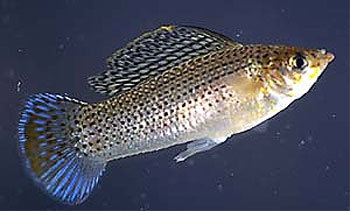- Poeciliidae
Taxobox
name = Poeciliidae

image_width = 250px
image_caption =Sailfin molly ("Poecilia latipinna")
regnum =Animal ia
phylum = Chordata
classis =Actinopterygii
ordo =Cyprinodontiformes
familia = Poeciliidae
familia_authority = Garman, 1895
subdivision_ranks = Genera
subdivision = "Alfaro " "Aplocheilichthys " "Belonesox " "Brachyrhaphis " "Carlhubbsia " "Cnesterodon " "Fluviphylax " "Gambusia " (mosquitofishes) "Girardinus " "Heterandria " "Heterophallus " "Hylopanchax " "Hypsopanchax " "Lacustricola " "Lamprichthys " "Limia " "Micropanchax " "Micropoecilia " "Neoheterandria " "Pamphorichthys " "Pantanodon " "Phallichthys " "Phalloceros " "Phalloptychus " "Phallotorynus " "Plataplochilus " "Poecilia " (mollies) "Poeciliopsis " "Poropanchax " "Priapella " "Priapichthys " "Procatopus " "Pseudopoecilia " "Quintana" "Scolichthys " "Tomeurus " "Xenodexia " "Xenophallus " "Xiphophorus " (swordtails, platys)Poeciliidae is a family of fresh-water
fish which are live-bearing aquarium fish (they give birth to live young). They belong to the orderCyprinodontiformes , tooth-carps, and include well-known aquarium fish like theguppy , molly, platy, andswordtail . The original distribution of the family was easternUnited States to northeasternArgentina , and central and southernAfrica , includingMadagascar . However, due to release of aquarium specimens and the widespread use of species of the genera "Poecilia " and "Gambusia " for mosquito control, poeciliids can today be found in all tropical and subtropical areas of the world.Live-bearing
Although the whole family Poeciliidae is known as "live bearers", there are in the family both true live-bearing "ovoviviparous" species, which have internal fertilization and the eggs hatch before being laid, so that the female gives birth to live young, and egg-scattering species with external fertilization. All African species are egg-layers, and with the exception of the members of the genus "
Fluviphylax " are all American species livebearers. This distribution suggests that Poeciliidae predate the split between Africa and South America 100 million years ago, that live-bearing subsequently evolved in south America, and that north-America was colonized by poeciliids following the formation of theisthmus of Panama 3 million years ago.Among the live-bearing species there are differences in the mode and degree of support the female gives the developing larvae; although many members of the family Poeciliidae are considered to be lecitrophic (meaning that the mother provisions the
oocyte with all the resources it needs "prior" to fertilization, so that the egg is independent of the mother), but others are matrotrophic (literally means "mother feeding": the mother provides the majority of resources to the developing offspring "after" fertilization).Members of the genus "
Poeciliopsis ", for example, show variable reproductive life history adaptations. "Poeciliopsis monacha ", "P. lucida", and "P. prolifica" form part of the same clade within the genus "Poeciliopsis". However, their modes of maternal provisioning vary greatly. "P. monacha" can be considered to be lecitrophic because it does not really provide any resources for its offspring after fertilization - the pregnant female is basically a swimming egg sac. "P. lucida" shows an intermediate level of matrotrophy, meaning that to a certain extent the offspring's metabolism can actually affect the mother's metabolism, allowing for increased nutrient exchange. "Poeciliopsis prolifica" is considered to be highly matrotrophic, and almost all of the nutrients and materials needed for fetal development are supplied to the oocyte after it has been fertilized."
Poeciliopsis elongata ", "P. turneri", and "P. presidionis" form another clade which could be considered an outgroup to the "P. monacha"/"P.lucida"/"P.prolifica" clade. These three species are very highly matrotrophic - so much so that in 1947 C. L. Turner described the follicular cells of "P. turneri" as "pseudo-placenta, pseudo-chorion, and pseudo-allantois".References
*
*
Wikimedia Foundation. 2010.
